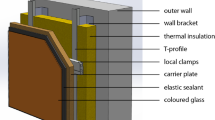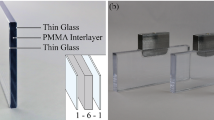Abstract
The trend towards large glass façades and the urge to reduce the material to a minimum requires further evolution in high performance transparent as well as lightweight structures. Therefore, a combination of polymeric interlayer core, chemically connected to cover layers of thin glass to reduce self-weight and to utilize the high durability of glass at the same time, is under development. The novel glass–plastic-composite panels behave as a unit and ensure a sufficient and high-performance load-bearing behaviour. The first studies, including four-point bending tests according to EN 1288-3 (2000), showed a nearly equivalent load-bearing behaviour to monolithic glass panes with the same nominal thickness. However, the composite load-bearing behaviour is significantly influenced by time- and temperature-dependent stiffness of the polymer interlayer material, as well as the shear connection between the interlayer core and glass cover layers. Hence, an extended experimental study on the load-bearing behaviour of the innovative composite panels was performed. This paper presents the new product with possible applications for the building industry and introduces the ongoing development and investigation process for the novel glass–plastic-composite panels. Afterwards, the test methods and results for the conducted short- and long-term four-point bending tests are given. Subsequently, the behaviour of the composite panels is compared to conventional glass, and the insights are discussed. This also includes a study on potential material models and analytical simulations to extend the results to large-scale application. The high structural performance and lower self-weight at the same time paves the way for high transparent glass construction with slender substructures.












Similar content being viewed by others
References
Andreozzi, L., Briccoli, Bati S., Fagone, M., Ranocchiai, G., Zulli, F.: Dynamic torsion tests to characterize the thermo-viscoelastic properties of polymeric interlayers for laminated glass. Const. Build. Mater. 65(2014), 1–13 (2014). https://doi.org/10.1016/j.conbuildmat.2014.04.003
DIN 18008: Glass in building—design and construction rules—part 1–6 (2010–2018)
EN 12337-1: Glass in building—chemically strengthened soda lime silicate glass—part 1: definition and description (2000)
EN 1288-3: Glass in building—determination of the bending strength of glass—part 3: test with specimen supported at two points (four point bending) (2000)
EN 13501-1: Fire classification of construction products and building elements—part 1: classification using data from reaction to fire tests (2009)
EN 572-2: Glass in building—basic soda lime silicate glass products—part 2: float glass (2012)
Feldmann, M., Langosch, K.: Zum Biegeverhalten von VSG-Laminaten unter Quer- oder Längsbelastung. In: Stahlbau Spezial, vol. 80, issue S1, pp. 52–60. Ernst und Sohn, Berlin (2011). https://doi.org/10.1002/stab.201120007
Fildhuth, T.: Design and monitoring of cold bent lamination-stabilised glass: investigated by applying fibre optic sensors. PhD Thesis, Universität Stuttgart (2015). https://doi.org/10.18419/opus-118
Galuppi, L., Royer-Carfagni, G.: The effective thickness of laminated glass plates. J. Mech. Mater. Struct. 7, 375–400 (2012). https://doi.org/10.2140/jomms.2012.7.375
Hänig, J., Bukieda, P., Engelmann, M., Stelzer, I., Weller, B.: Examination of laminated glass with stiff interlayers—numerical and experimental research. Int. J. Struct. Glass Adv. Mater. Res. 3, 1–14 (2019). https://doi.org/10.3844/sgamrsp.2019.1.14
ISO 12543-4: Glass in building—laminated glass and laminated safety glass—part 4: test methods for durability (2011)
ISO 527-1: Plastics—determination of tensile properties—part 1: general principles (2012)
ISO 6721-1: Plastics—determination of dynamic mechanical properties—part 1: general principles (2011)
Juang, Y., Lee, L.J., Koelling, K.W.: Rheological analysis of polyvinyl butyral near the glass transition temperature. Polym. Eng. Sci. 41(2), 275–292 (2004). https://doi.org/10.1002/pen.10727
Kraus, M.A., Schuster, M., Kuntsche, J., Siebert, G., Schneider, J.: Parameter identification methods for visco- and hyperelastic material models. Glass Struct. Eng. 2(2), 147–167 (2017). https://doi.org/10.1007/s40940-017-0042-9
Kuntsche, J., Schuster, M., Schneider, J., Langer, S.: Viscoelastic properties of laminated glass interlayers—theory and experiments. In: Glass Performance Days 2015 Tampere Conference Proceedings, pp. 143–147 (2015)
Kunz, J.: Component design: creep resistance—a characteristic value for creep behaviour. In: Kunststoffe International 2004/01 (2004)
Kuraray Europe GmbH Division TROSIFOL: Verbund-Sicherheitsglas mit der PVB-Folie TROSIFOL ES mit Schubverbund abz Z-70.3-236 (2016)
Louter, C., Akilo, M.A., Miri, B., Neeskens, T., Ribeiro Silveira, R., Topcu, Ö., Van der Weijde, I., Zha, C., Bilow, M., Turrin, M., Klein, T., O’Callaghan, J.: Adaptive and composite thin glass concepts for architectural applications. Heron J. 63(1—-2), 1–22 (2018)
Nehring, G., Siebert, G.: Design concept for cold bent shell structures made of thin glass. In: Engineered Transparency 2018, pp. 43–56. Ernst und Sohn, Düsseldorf (2018). https://doi.org/10.1002/cepa.909
Neugebauer, J., Wallner-Novak, M., Lehner, T., Wrulich, C., Baumgartner, M.: Movable thin glass elements in façades. In: Challenging Glass Conference Proceedings, vol. 6, pp. 195–202. Delft (2018). https://doi.org/10.7480/cgc.6.2133
prEN 16613: Glass in building—laminated glass and laminated safety glass—determination of interlayer mechanical properties (2017)
Sackmann, V.: Untersuchungen zur Dauerhaftigkeit des Schubverbunds in Verbundsicherheitsglas mit unterschiedlichen Folien aus Polyvinylbutyral. PhD Thesis, Technische Universität München (2008)
Schneider, J.K., Kuntsche, J., Schula, S., Schneider, F., Wörner, J.: Glasbau Grundlagen, Berechnung, Konstruktion. Springer, Berlin (2016). ISBN 3540284761
Siebert, G., Maniatis, I.: Tragende Bauteile aus Glas: Grundlagen, Konstruktion, Bemessung, Beispiele. Ernst und Sohn, Berlin (2012). ISBN 9783433029145
Weller, B., Engelmann, M.: Nonlinear effects in testing of flat and curved glass. In: Engineered Transparency 2012, pp. 259–272. Ernst und Sohn, Düsseldorf (2012)
Wölfel, E.: Nachgiebiger Verbund—Eine Näherungslösung und deren Anwendungsmöglichkeiten. In: Stahlbau 56, Heft 6, pp. 173–180 (1987)
Acknowledgements
The investigations are conducted as part of a research Project supported by the German Federal Ministry of Economic Affairs and Energy. The authors would like to thank the Project partner KRD Coatings GmbH for the close co-operation, the technical support with respect to the production of all needed test specimens.
Funding
Funding was provided by German Federal Ministry of Economic Affairs and Energy (Grant No. ZF4123716HF8).
Author information
Authors and Affiliations
Corresponding author
Ethics declarations
Conflict of interest
On behalf of all authors, the corresponding author states that there is no conflict of interest.
Additional information
Publisher's Note
Springer Nature remains neutral with regard to jurisdictional claims in published maps and institutional affiliations.
Rights and permissions
About this article
Cite this article
Hänig, J., Weller, B. Load-bearing behaviour of innovative lightweight glass–plastic-composite panels. Glass Struct Eng 5, 83–97 (2020). https://doi.org/10.1007/s40940-019-00106-5
Received:
Accepted:
Published:
Issue Date:
DOI: https://doi.org/10.1007/s40940-019-00106-5




